
| WWT Shows | CLICK TO: Join and Support Internet Horology Club 185™ | IHC185™ Forums |

|
• Check Out Our... • • TWO Book Offer! • |
Welcome Aboard IHC185™  Internet Horology Club 185
Internet Horology Club 185  IHC185™ Discussion Site Main Page
IHC185™ Discussion Site Main Page  Horological Discussions, Questions and Answers
Horological Discussions, Questions and Answers  European Pocket Watch Forum
European Pocket Watch Forum  FUSEE' - WHAT DO YOU SEE ?
FUSEE' - WHAT DO YOU SEE ?
 Internet Horology Club 185
Internet Horology Club 185  IHC185™ Discussion Site Main Page
IHC185™ Discussion Site Main Page  Horological Discussions, Questions and Answers
Horological Discussions, Questions and Answers  European Pocket Watch Forum
European Pocket Watch Forum  FUSEE' - WHAT DO YOU SEE ?
FUSEE' - WHAT DO YOU SEE ?Go  | New Topic  | Find-Or-Search  | Notify  | Tools  | Reply to Post  |  |
| IHC President Life Member |
Since we recently discussed a really important E. Howard Experimental Series, Major Find this topic should be interesting. Earlier today an eMail question along with the image you see below this message came to us. The owner would like to have information on what they referred to as a "family heirloom" with an "Edw. Howard, London 1697" inscription on the plates. So everyone I ask you, tell us what you see here... 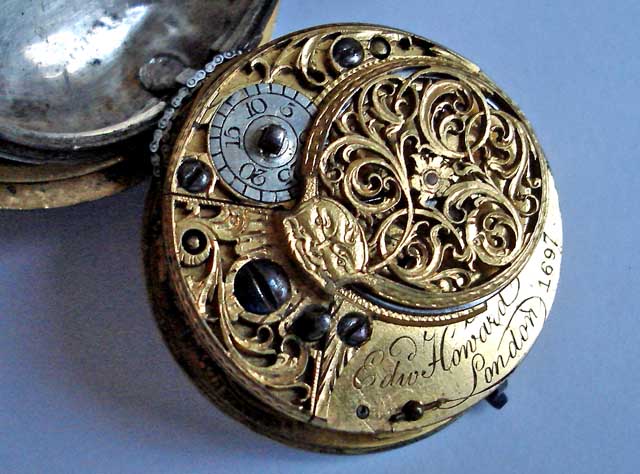 | ||
|
| IHC President Life Member |
Looks like there is a problem with the chain drive... .jpg) | |||
|
| E. Howard Expert |
This gentleman found my name on the Internet and wrote me a letter a week or so ago. Unfortunately, I'm not the authority he had hoped to find on this subject. (He sent the letter to my business address, which further surprised me. Apparently he found a reference to one of my physics papers or presentations, probably at an American Physical Society meeting). I haven't had a chance to answer the gentleman yet, but I fear I have little useful information for him in any case beyond the fact that his watch was made in London (which he already knew), probably of the pre-19th century verge fusee type. And of course it bears no connection whatsoever, other than a pure accident of name, with the Edward Howard of importance in American horology. | |||
|
| IHC President Life Member |
Thanks Clint, the owner has a link to this topic and access the responses. | |||
|
This is probably from the Edward Howard that Baillie lists as working in London from 1780-1804. The piercing of the plates also looks to be from the late 1700s. It looks to be a fairly typical verge escapement fusee of the period. The loose fusee chain is not necessarily a major problem as these are repairable. A photo or description of the hallmarks in the case would help pin the date down more precisely. | ||||
|
I would love to see those hallmarks too! Nice looking watch, and lots of info on the name Edw Howard in London, so the date would make a huge difference in a search. Sheila | ||||
|
Lindell, Can you get various 'side' pic's of the plates, pillars and other furniture?? Their style may give more clues about the movement period etc. (Tulip / Egyptian / Round etc). Does the fusee have a worm and wheel arrangement etc? Nicely fretted top plates and typical 'Grotesque mask' on the balance cock, also 'Thompion' style regulator (probably silver). Note the moveable plug (endstone / pivot bush) on the balance cock, may be an old repair, as the staff often wears a hole through the 'cock' top face!. I would say the number relates to the movement rather than any year of manufacture. That Fusee chain is a chunky beast too ..... look at the size of those rivets! Could have just flipped off, or caused to do so by a broken mainspring / links / hooks - or maybe badly worn pivots & holes causing the mainspring barrel to tilt and the chain to slip off! I'm currently repairing a chain on a Swiss verge, and the link pins are so small I'm having to use a 20x mag bino scope to repair it using a wristwatch pivot from a balance staff!! I've nothing else around that small! Beware that although Hallmarks will determine the age of the case, they will Not necessarily be that of the movement. With a watch of that age, it wouldn't be unusual to see one recased at some point, whether through wear or damage, or even a move to silver following scrapping of a Gold case etc! Is it a 'Pair Case' and if so, do the hallmarks match? Any signs of 'key holes' being filled and moved? (Marriages)! If you can get the dial off, there may be more information there, such as service and repair dates (with names if lucky), or a redial etc! John. | ||||
|
I forgot to mention that, in the 2006 watch guide, on page 446, it says that the face was added to the design about 1720. Boy look at this great information on a fusee, I just love your input guys. I have a fusee I've been looking up myself, and this kind indormation will help me a lot. Sheila | ||||
|
I also found this movement and it says Edw. Howard- Kirby Street London No face, but the same name. Sheila 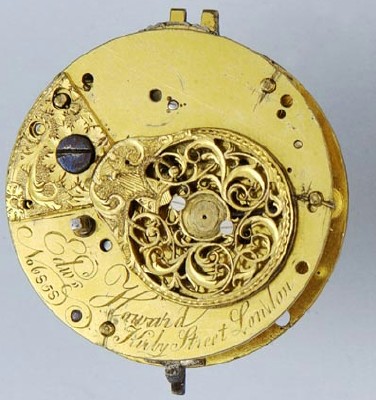 | ||||
|
| IHC President Life Member |
Here are four additional images which may prove interesting. In this one we see the dial-side when first opened... 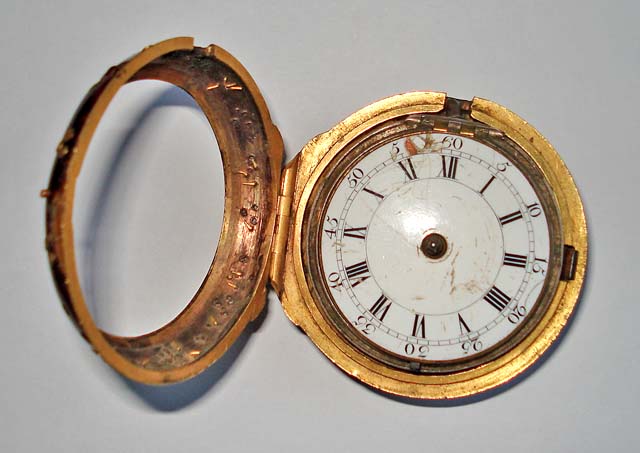 | |||
|
| IHC President Life Member |
In this image we see both cases and more details... 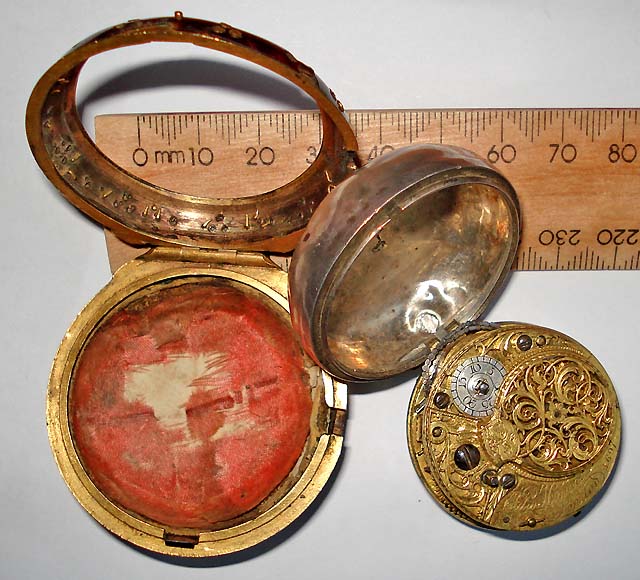 | |||
|
| IHC President Life Member |
Hallmarks on the left are described as"a small raised stamp I cannot distinguish" and "RP" by the owner. The case-back is referred to as having a "tortoise shell" finish to it. Hallmarks on left and the outer case-back on right...  | |||
|
| IHC President Life Member |
Movement showing a glimpse of pillar and details... 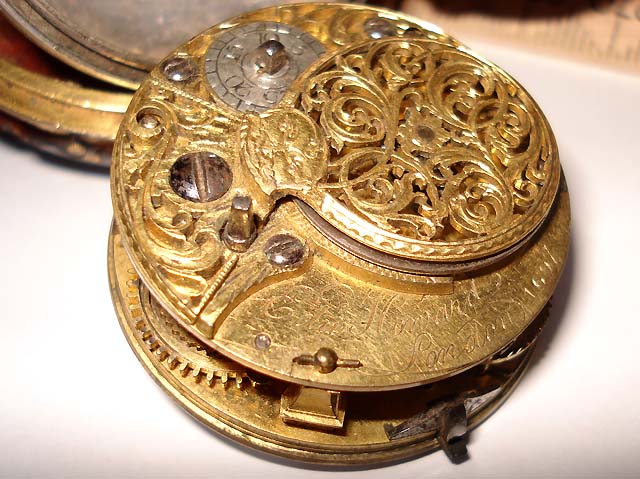 | |||
|
Lindell, Well, the lion does make it Sterling Silver, that much I do know, and boy those pictures sure make it interesting! I bet this one is quite old, and I hope to get my makers mark book here soon, so I can look up the letters in the case. I know it won't help with the watch, but may help with a date. It looks as if the case is original to the watch, what do you think? Does it look that way "in person"? Nice Watch! Sheila | ||||
|
Nice Photo's of a nice watch Lindell! The pillars are desribed as 'Egyptian' or 'Square' and a style generally sought after by collectors. If anyone's feeling picky, they're not quite as desireable as the Tulip pillars, but more so than round ones!. Nice to see it still has its cases! They often get lost or trashed over the years! I recently saw one similar at a local auction, with 4x cases and a perfect dial! (2x solid silver inners, 1x Tortoise shell outer and a Shagreen protector - Sold for £420 GBP + 15% Comm.)! Someone got very very lucky that day! The nearest casemakers I can find using a registered mark similar to that shown, is Richard Palmer 1. working at No 2. Red Lion St, Clerkenwell. In operation from 10 June 1769 - 17 March 1795. Then follows Richard Palmer 2. Working at Bishops Court, Clerkenwell. 30 Dec 1793 - 1794, moving to 18 Sutton St, Clerkenwell 7 July 1794. In 1795 the marks were registered to Richard Palmer and Charles Staffell, but they used a crest to house the initials. The last registration of those initials was by Russell Pontifex, 24 Primrose St, Bishopsgate St. 5 June 1798. I've included all three, because all three used the initials 'Incursive' at least once without a shield, but no mention is made of raised letters in the listings. I can only assume, that the casemaker's and Sterling marks were originally engraved into the end of the punch used to shape the bowl of the case for it to be formed in that way. If so I think it would be quite unusual, as I believe the assay office would have stamped them normally! Doubtless that punch would have been securely locked up at night if so! Potential for a 'nice little earner' if not! I'll dig out my 'William Wightman' Verge movement for you to look at soon, trouble is I then don't get any work done for a while for just looking at it!! Wightman was apprenticed to Joseph Windmills in 1686! Awsome to look at the quality of Workmanship of those things considering their era and, lack of the facilities we so take for granted, even down to lighting used! John | ||||
|
| Powered by Social Strata |
| Your request is being processed... |
|
©2002-2025 Internet Horology Club 185™ - Lindell V. Riddle President - All Rights Reserved Worldwide

